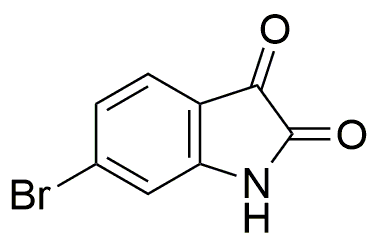6-Bromoisatin is widely utilized in research focused on:
- Pharmaceutical Development: This compound serves as a crucial intermediate in the synthesis of various pharmaceuticals, particularly those targeting cancer and bacterial infections. Its unique structure allows for the development of novel therapeutic agents.
- Organic Synthesis: It is employed in organic chemistry as a building block for creating more complex molecules. Researchers often use it to explore new synthetic pathways, enhancing the efficiency of chemical reactions.
- Biological Studies: 6-Bromoisatin is used in biological research to investigate its effects on cellular processes. Its ability to inhibit specific enzymes makes it a valuable tool for studying metabolic pathways and disease mechanisms.
- Material Science: In the field of material science, this compound is explored for its potential in developing organic electronic materials. Its electronic properties can be harnessed in creating more efficient organic light-emitting diodes (OLEDs).
- Analytical Chemistry: It is also utilized in analytical methods to detect and quantify various substances. Its distinct chemical properties allow for the development of sensitive assays, benefiting quality control in pharmaceuticals.
General Information
Properties
Safety and Regulations
Applications
6-Bromoisatin is widely utilized in research focused on:
- Pharmaceutical Development: This compound serves as a crucial intermediate in the synthesis of various pharmaceuticals, particularly those targeting cancer and bacterial infections. Its unique structure allows for the development of novel therapeutic agents.
- Organic Synthesis: It is employed in organic chemistry as a building block for creating more complex molecules. Researchers often use it to explore new synthetic pathways, enhancing the efficiency of chemical reactions.
- Biological Studies: 6-Bromoisatin is used in biological research to investigate its effects on cellular processes. Its ability to inhibit specific enzymes makes it a valuable tool for studying metabolic pathways and disease mechanisms.
- Material Science: In the field of material science, this compound is explored for its potential in developing organic electronic materials. Its electronic properties can be harnessed in creating more efficient organic light-emitting diodes (OLEDs).
- Analytical Chemistry: It is also utilized in analytical methods to detect and quantify various substances. Its distinct chemical properties allow for the development of sensitive assays, benefiting quality control in pharmaceuticals.
Documents
Safety Data Sheets (SDS)
The SDS provides comprehensive safety information on handling, storage, and disposal of the product.
Product Specification (PS)
The PS provides a comprehensive breakdown of the product’s properties, including chemical composition, physical state, purity, and storage requirements. It also details acceptable quality ranges and the product's intended applications.
Certificates of Analysis (COA)
Search for Certificates of Analysis (COA) by entering the products Lot Number. Lot and Batch Numbers can be found on a product’s label following the words ‘Lot’ or ‘Batch’.
*Catalog Number
*Lot Number
Certificates Of Origin (COO)
This COO confirms the country where the product was manufactured, and also details the materials and components used in it and whether it is derived from natural, synthetic, or other specific sources. This certificate may be required for customs, trade, and regulatory compliance.
*Catalog Number
*Lot Number
Safety Data Sheets (SDS)
The SDS provides comprehensive safety information on handling, storage, and disposal of the product.
DownloadProduct Specification (PS)
The PS provides a comprehensive breakdown of the product’s properties, including chemical composition, physical state, purity, and storage requirements. It also details acceptable quality ranges and the product's intended applications.
DownloadCertificates of Analysis (COA)
Search for Certificates of Analysis (COA) by entering the products Lot Number. Lot and Batch Numbers can be found on a product’s label following the words ‘Lot’ or ‘Batch’.
*Catalog Number
*Lot Number
Certificates Of Origin (COO)
This COO confirms the country where the product was manufactured, and also details the materials and components used in it and whether it is derived from natural, synthetic, or other specific sources. This certificate may be required for customs, trade, and regulatory compliance.


